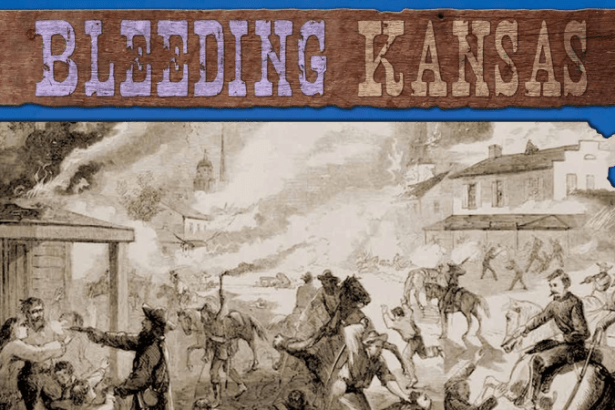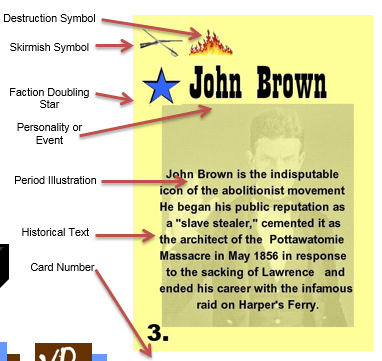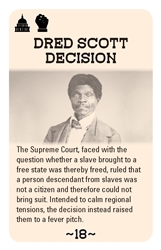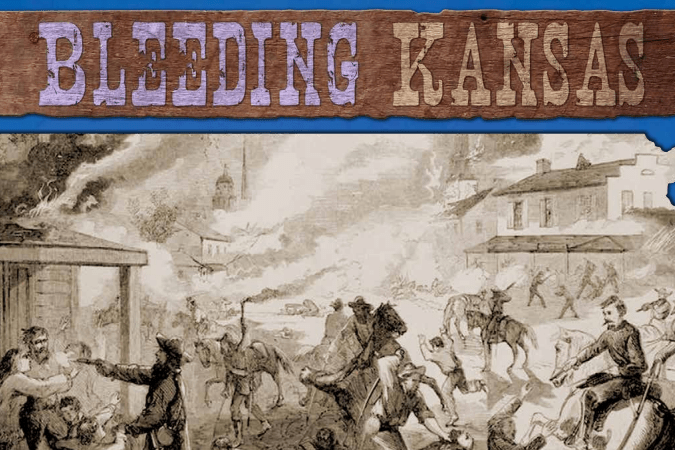We have done multiple interviews with John Poniske covering his great games over the past few years. Games including The Berlin Airlift from Legion Wargames, Plains Indian Wars from GMT Games, Blood on the Ohio: The Northwest Indian War, 1789-1794 from Compass Games, Revolution Road from Compass Games and The Devil Dogs of Belleau Wood from Worthington Games to name a few. He is a very thoughtful designer that isn’t afraid to tackle less gamed and somewhat controversial subjects and takes his time to do the research and get things right to carry the theme of the conflicts/situations he is portraying. When I saw that Decision Games was releasing one of his designs called Bleeding Kansas, I knew I had to reach out to him to get more information.

Grant: We haven’t really spoken to you since last July at WBC. I heard there have been some big developments. What is new in your life?
John: Two weeks ago I retired from teaching. I may return to it if a college position opens up, until then I will continue working on my designs, do a little fiction writing (Civil War themed) and tend to the odd job with Visiting Angels (a care organization that assists the elderly). Other than that, looking forward to a trip to China in October.
Grant: What have you been doing with your new found time? Designing more great games?
John: Top of the list is the lengthy Honey-do list that has grown over the past couple of years. Over the past two weeks I have undertaken the following: Heavy duty gardening, major bush trimming, tile work in the kitchen, game-room reorganization (ongoing), stripping and painting our spare bedroom, power-washing the house, deck & fence and coordinating contractor estimates for our church. Phew…I think that’s it, oh – besides design work on the side.
Grant: What is something you’ve always wanted to do that you’ll now get to do?
John: Two primary things. Increase my weekly workouts and write historical fiction – with a view to the Civil War.
Grant: What is the story on your new upcoming game from Decision Games called Bleeding Kansas?
John: I just received an advanced copy and am VERY happy with the production quality. The theme has niggled at me for a number of years, then a couple years back, it all came together in a single week. I worried over the controversial subject matter but was overjoyed when Doc from Decision Games gave me the thumbs up on it.
Grant: Where did the name for the game come from? What image does it convey from the historical happenings?
John: The name is a historic meme originated by the pre-Civil War media. It overstated the division and violence that existed in Kansas over the decision to let the state’s population decide its own rules on slavery. This in turn led to both slavers and abolitionists promoting migration to the region. This in turn led to intimidation and violence…but nowhere near the violence indicated by the name Bleeding Kansas.
“Bleeding Kansas” is a term coined by newspaper editor Horace Greeley to describe the bitter clash between anti-slavery and pro-slavery factions. Both sides fought and spilled blood over Kansas joining the Union as a free or slave state.
Grant: What drew you to this topic to design a game?
John: I am fascinated by the American Civil War and this seminal conflict which fed the rising tensions in the U.S.. I also wanted to raise the consciousness of our gaming industry to the fact that the Civil War was more than organized units facing organized units. Sometimes the central issue was very disorganized
Grant: What challenges and opportunities did the subject present to you?
John: Oh my, that’s a can of worms. I’ll try to keep it short. 1) the very nature of the beast – someone has to play the pro-slavery side and I was not at all sure that was going to go over well. 2) What was the goal to be? Historically the goal was to have the territory’s population either approve of slavery or vote it down. I decided this was to be based on a series of elections which gave birth to an election track which came to double as an ancillary VP track. 3) Since fighting was only a small segment of the overall period I had to give the players a variety of things to do, a variety of choices. These choices include: Politicking, Skirmishing, Influencing, Movement, Cooperating, Destruction and Emigration. 4) But how do I tell the story? I decided to make this a CDG with each card giving a piece of the historic story and a limited number of the previously mentioned choices (Each also includes a contemporary drawing of the incident described). 5) Finally, there was the question of the emigrants that flooded into and through the territory. How to handle them? How to decide who stopped and who continued? How to decide whose faction they chose? I did this through the choices of Migration, Influence and Cooperation, and a static action that moves any uncommitted emigrant cubes West at the end of every turn until they leave the territory. Hmmm, that wasn’t too short was it?
Grant: What from history did you want to include and model in the game? How did you accomplish this?
John: First, I wanted to get across to players that it was less of a war game than a game of influence, a game of intimidation. I also wanted to indicate what role the government played through the administrations of Pierce and Buchanan and how politicians like Lincoln, Douglas, Sumner and Atchison helped shape the conflict. Second I wanted to make it clear that the end result was long in doubt and that for some time there were actually competing territorial governments working against each other. And ultimately I wanted to show how savage and underhanded both sides were. This was, after all, where John Brown earned his brutal reputation.
 Grant: Why did you feel the Card Driven game mechanic was best for the design?
Grant: Why did you feel the Card Driven game mechanic was best for the design?
John: As I said cards are a beautiful platform to tell the historic story and share bits about the history in flavor text.
Grant: Why do you feel no one has designed a game on this subject before? Why are you doing so now?
John: That’s easy, slavery is a touchy subject. Why me, why now? Any creator, be he or she, a writer, actor, photographer or designer, will tell you – when the muse won’t let you go, you do what the muse wants.
Grant: The game plays with cubes on the map. What factions do the various color of cubes represent? Is this an area control aspect?
John: The cubes are brown/slavers, blue/abolitionists, black/federal army and white/emigrants. Yes, this is an area control game. The areas are Kansan counties.

Grant: What is the anatomy of the cards? What are the different symbols and what do they allow the player to do?
John: Each card has 2-3 symbols, a contemporary drawing related to the event, a description of the event itself and an identifying card number. The symbols themselves are as follows:
Colored Star – Choice of any Action – playable by faction only
Politics – Place a factional Political token on the election track
Skirmish – engage in a county battle. Casualties are always low.
Influence – attempt to sway migrants to your faction
Movement – Move any/all of your cubes from county to county
Destruction – Burn a town by placing a damage marker
Migration – Move all emigrants and add new emigrants
Cooperation – Choice of three different select actions:
1) Move the Troops cube to a county of your choosing; 2) Remove a damage marker from a burned town; or 3) Force an opponent’s cube out of a county.
 Grant: How did you decide on the deck size of 53 cards? What is the Joker used for?
Grant: How did you decide on the deck size of 53 cards? What is the Joker used for?
John: There is a single deck and its size has a boring origin story. I wanted to keep it to a standard deck size to reduce production costs. The deck is both symmetrical and asymmetrical. Symmetrical in that both factions have an equal number of colored stars affording each side an equal number of additional action choices. Also, each of the different actions occurs an equal number of times in the deck. It is asymmetrical in that each card gives players one or more choices. The Joker in the game is like the colored stars except that it affords both players a choice of any action – but only one action.
Grant: Why did you settle on having each card contain two symbols? Why not 3? Or 4?
John: Simply to avoid player angst and to speed the game along. Although an equal number of cards have colored stars as well – allowing players a third option.
Grant: Can you provide us a few examples of cards and help us understand how they are used?
 John: How ‘bout the card example given in the rulebook? The Abolitionist player or Anti-Slavery (A.S.) player plays the John Brown card. He uses the Skirmish symbol (crossed weapons) to engage two brown Pro-Slavery (P.S.) cubes in Shawnee County where three blue A.S. cubes reside and where the Anti-slavery faction has two integral influence because of its capital. Both sides roll 1D6. The A.S. roll is a 5. The P.S. roll is a 4. The A.S. player adds 3 for his cubes, 2 for his capital and 5 for his die roll giving him a total of 10. The P.S. player adds 2 for his cubes to his die roll of 4 for a total of 6. The difference is 4 so the P.S. player must lose one of his cubes because the difference is greater than 3. The victor then moves the remaining P.S. cube North into Jackson county where the P.S. player has no other cubes. Finally, he places a Violence counter on the Election Track. For his second action, the A.S. decides to use Destruction (The Flames) to burn LeCompton and places a Destruction counter on the town. This removes one P.S. influence in the county. For this, he also places another violence counter on the Election Track. Thirdly, the A. S. Player uses his blue star to choose a Political Action and places a political marker on the Election Track. The A.S. player has placed three blue counters on the Election Track bringing the upcoming election ever closer and the A.S. player is three influence points nearer to winning the election and the two Victory Points that go with it.
John: How ‘bout the card example given in the rulebook? The Abolitionist player or Anti-Slavery (A.S.) player plays the John Brown card. He uses the Skirmish symbol (crossed weapons) to engage two brown Pro-Slavery (P.S.) cubes in Shawnee County where three blue A.S. cubes reside and where the Anti-slavery faction has two integral influence because of its capital. Both sides roll 1D6. The A.S. roll is a 5. The P.S. roll is a 4. The A.S. player adds 3 for his cubes, 2 for his capital and 5 for his die roll giving him a total of 10. The P.S. player adds 2 for his cubes to his die roll of 4 for a total of 6. The difference is 4 so the P.S. player must lose one of his cubes because the difference is greater than 3. The victor then moves the remaining P.S. cube North into Jackson county where the P.S. player has no other cubes. Finally, he places a Violence counter on the Election Track. For his second action, the A.S. decides to use Destruction (The Flames) to burn LeCompton and places a Destruction counter on the town. This removes one P.S. influence in the county. For this, he also places another violence counter on the Election Track. Thirdly, the A. S. Player uses his blue star to choose a Political Action and places a political marker on the Election Track. The A.S. player has placed three blue counters on the Election Track bringing the upcoming election ever closer and the A.S. player is three influence points nearer to winning the election and the two Victory Points that go with it.
Grant: What is the election track and how does it affect game play?
John: As you just experienced, politics and violence give the two factions influence in upcoming elections. The player who amasses the most colored counters during an election period wins two victory points. If the score is tied, both sides earn one victory point. If a player is able to play two political markers in the same turn he can remove all opposing political markers in that electoral period.
Grant: How do the elections occur in the game and what is the outcome? Why is this important?
John: Kansan territorial elections amounted to control. Elections were neither fair nor representative but elections were followed closely by the rest of the nation. They were in effect the national thermometer gauging slavery fever. Victory is based on county control augmented by election influence.
Grant: How did you incorporate the fraudulent election of 1855 into the design? Why was this important?
John: The election of 1855 was possibly the most crooked electoral process the nation has ever experienced. In this, the first Kansan territorial election, 5,000 “Border Ruffians” poured into the territory from western Missouri forcing the election of a pro-slavery legislature. The number of votes cast, exceeded the number of eligible voters in the territory. Still, Governor Andrew Reeder approved the election to end the violence and intimidation. This led directly to the establishment of an opposing abolitionist government in Kansas. How did I incorporate it – by allowing violence counters equal standing to political counters on the Election Track.
Grant: What is the Coordination Bonus and why is it important? What does this represent from history?
John: Any time you can prove your hand of three cards show six of the seven card symbols: Skirmish, Destruction, Politics, Migration, Movement, Cooperation and Influence, you can discard your entire hand to automatically receive one Victory Point. Note – The faction star is not one of the seven symbols. This represents the rising power of militia groups, both Pro and Anti-Slavery groups.
Grant: What was the Politital track originally a pyramid? What does this represent?
John: As a side note, the reason I originally configured the Political track as a pyramid was a nod to our only bachelor president, James Buchanan. He is the only U.S. President buried beneath a pyramid (of native Pennsylvania stone). I’ve visited the spot in Franklin County where I live – it’s…bizarre! I argued to have the track remain as I originally created it but the developers had other ideas.
The first point pyramid, later changed to a track, reflected the violent political furor over the race question in Bleeding Kansas. Each time a player uses one or more Skirmish, Destruction or Political card symbols, the same number of corresponding Political and/or Violence markers is/are placed on the current election track. A Political marker is placed for each Political symbol played. A Violence marker is placed for each Skirmish or Destruction symbol played. Players play their own faction markers and place them in the lowest numbered space in the current election track.
The Election track covers four elections – 1854, 1855, 1857, 1859. When a player’s marker is placed on an election space, an election is triggered.
- The person with the most markers on the election track earns two bonus VPs, this is recorded on the VP track. If both players have an equal number of markers on the election track each player is awarded one VP.
- Players then count the number of counties they control.
- A Player who has a clear majority of force points controls the county.
Grant: The map covers both Kansas and Missouri but the game focuses on the state of Kansas. Why is this the case?

John: Why Kansas – that’s obvious. Why Missouri – because that is where the vast majority of Kansan emigrants were traveling through. Also, Missouri was a slave state and had a vested interest in seeing Kansas enter into the slavery fold. Remember this is where those 5000 border ruffians entered into Kansas.
Grant: What is the goal for players? How do they win the game?
John: The goal of players is to have the most control through county predominance to which is added electoral victory points. County control is obtained by having the largest factional presence within the region. This can be accomplished through movement. Through reducing competition by skirmishing and destruction or by recruiting emigrants.
Grant: How long do games typically last? Was this your design goal?
John: Games last 1 ½ to 2 hours. Yes absolutely this was my goal. I try very hard to create designs that last no more than 3 hours. 1 ½ hours is the sweet spot!
 Grant: What changed with the game over the course of development and play testing? What element was hardest for you to let go of or change?
Grant: What changed with the game over the course of development and play testing? What element was hardest for you to let go of or change?
John: Honestly, very little. This is one of the few designs that was birthed almost fully formed. I tinkered some with the map and the election track but overall what you get is how it originally came to mind.
Grant: What are you most pleased with about the design? What does it do well?
John: It tells the story. It helps players understand that our National Civil War grew out of the territorial civil war in Kansas. Oh, and I am particularly fond of the pyramidal election track. I’m betting only a fraction of a fraction of Americans know of Buchanan’s curious burial place. With this publication, it will be a slightly larger fraction.
Grant: When is the game being released?
John: Doc informed me he will be demonstrating the game at this year’s WBC where Bleeding Kansas will be officially released.
Grant: What other designs are you currently working on?
John: My son and I are proud to announce the release of Worthington Game’s The Devil Dogs of Belleau Wood this coming WBC as well. In addition I continue work on Fire on the Mountain, Pontiac’s Uprising, Black Eagles, The Berlin Airlift and my most successful non-historical game yet, On a Roll. The latter is a stock market, dice rolling game that I have yet to submit to anyone.
Thanks for taking an interest in my work Grant.
 As always, this game looks interesting and I can’t wait to give it a try. I appreciate your time John and the fact that you design games that normally would never get to be played out on cardboard.
As always, this game looks interesting and I can’t wait to give it a try. I appreciate your time John and the fact that you design games that normally would never get to be played out on cardboard.
If you are interested in Bleeding Kansas, you can order a copy for $69.00 from the Decision Games website at the following link: http://shop.decisiongames.com/ProductDetails.asp?ProductCode=1907
-Grant

I read the designer notes in a pre-production copy that Decision had at SD Histcon last year, really looking forward to getting this.
LikeLiked by 1 person
I think it looks good and quick to learn and play. I’m picking up a copy at WBC.
LikeLike
Sounds interesting; I’ll look for the demo at WBC.
How is the Election Track pyramidal – it looks like a linear track, just folded-over to fit the available map space? I would have thought it would take ever more influence to move the electoral needle – like an inverted pyramid?
LikeLike
Thanks for giving the game a shout-out, Grant.
And Norm, The Election Track is no longer a pyramid. It was a design decision that fell by the way. You are right It does take ever more influence to move the electoral needle – that’s how the game play works. The original track was shaped like a pyramid solely to draw attraction to Buchanan’s death memorial.
LikeLike
We played Bleeding Kansas multiple times at the CSW EXpo last month, and enjoyed it very much!
LikeLiked by 1 person
Hey Grant… just viewed your #2 addition to “Bleeding Kansas”…. great stuff! I’ve been a fan of this game and the designer for some time…. since the “1st Nation” series of games he put out (Navajo Wars, Blood on the Potomac, Maori Wars, etc). I’m always on the search for something new, innovative and a game that teaches me something NEW about American history. This CLICKS all the boxes. One question though… how does it solo? I’m not likely to have another player to always get this game on the table… ???? Thanks again for always going the extra mile.
LikeLike
It doesn’t have a solo mode but you can just play both sides. I’d recommend not knowing the opponent cards and just draw one and play.
LikeLike
Please stop changing my posts and placing them on your site without giving us proper credit.
LikeLike